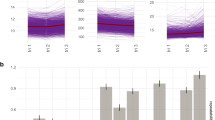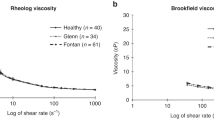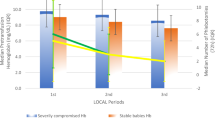Abstract
ABSTRACT: Rheological parameters were measured in 10 pairs of mothers and newborns. Whole blood viscosity was similar despite a higher fetal hematocrit (47.0 ± 5.1 versus 35.5 ± 12.0%, mean ± SD, p < 0.05). When the hematocrit of the suspension of red cells in plasma was adjusted to 45%, the viscosity was significantly lower in the fetal blood over a wide range of shear rates (0.52-208 s-1). The main reason for the lower viscosity in the fetal blood was the lower plasma viscosity as compared to the maternal blood (1.08 ± 0.05 versus 1.37 ± 0.08 centipoise, p < 0.05); this in turn was attributable to a lower total plasma protein concentration (4.74 ± 0.71 versus 6.47 ± 0.64 g/dl, p < 0.05). All protein fractions were lower in the fetal plasma. The assessment of red cell deformability by filtration through polycarbonate sieves revealed that the resistance of a fetal red cell was three times higher than that of a maternal red cell in a 2.6-μm pore, but there was no significant difference in resistance for these red cells in 6.9-μm pores. This higher filtration resistance of fetal red cells through the small pores was mainly due to their large volume (115.4 ± 10.8 versus 93.5 ± 5.9 fl, p < 0.001). Measurements on membrane-free hemoglobin solutions indicated that the internal viscosity of these two types of red cells was not different. We conclude that in fetal blood the higher hematocrit and the presence of larger red cells, which cause impaired passage through pores < 5 μm, are counterbalanced by a decreased plasma viscosity, resulting in a whole blood viscosity comparable to that of adults.
Similar content being viewed by others
Log in or create a free account to read this content
Gain free access to this article, as well as selected content from this journal and more on nature.com
or
Author information
Authors and Affiliations
Rights and permissions
About this article
Cite this article
Reinhart, W., Danoff, S., King, R. et al. Rheology of Fetal and Maternal Blood. Pediatr Res 19, 147–153 (1985). https://doi.org/10.1203/00006450-198501000-00038
Received:
Accepted:
Issue date:
DOI: https://doi.org/10.1203/00006450-198501000-00038
This article is cited by
-
Development of a new staining protocol for the Kleihauer–Betke test to facilitate the reading of difficult cases
BMC Pregnancy and Childbirth (2024)
-
Hemodynamics in a Pediatric Ascending Aorta Using a Viscoelastic Pediatric Blood Model
Annals of Biomedical Engineering (2016)
-
Effects of Intralipid infusion on hemorheology and peripheral resistance in neonates and children
Pediatric Surgery International (2005)
-
Modelling of the Blood Flow Circulation in the Human Foetus by the End of the Third Week of Gestation
Cardiovascular Engineering (2005)
-
Erythrocyte deformability and microhematuria in children and adolescents
Pediatric Nephrology (2003)



